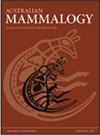Spot the difference: optimising camera trap use to detect and identify individuals of a medium-sized carnivorous marsupial
IF 0.9
4区 生物学
Q3 ZOOLOGY
引用次数: 0
Abstract
Camera trap model and setup choice can significantly affect data collection. This study investigated standard-angle Reconyx and wide-angle Swift camera traps in different setups and how the choice of equipment influenced detection and individual identification of the chuditch (Dasyurus geoffroii). Camera models were placed side-by-side in four setups: (i) single and (ii) paired camera traps 30 cm above ground; and single cameras (iii) 1 m and (iv) 2 m above ground, with a lure (tuna oil) in the centre of all setups. Swifts had a higher Detection probability than Reconyx, although the number of detections with identified individuals did not significantly differ between camera models. The 30 cm paired camera setups had the highest Detection and Identification probabilities for both camera models, with both probabilities decreasing as cameras were positioned higher. Camera model and setup choice are important in obtaining detection and identification data, and should be considered when planning studies and interpreting results.发现差异:优化相机陷阱的使用,以探测和识别中型食肉有袋类动物的个体
照相机诱捕器的型号和设置选择会对数据收集产生重大影响。本研究调查了标准角度 Reconyx 摄像机陷阱和广角 Swift 摄像机陷阱在不同设置下的使用情况,以及设备的选择如何影响恙虫(Dasyurus geoffroii)的探测和个体识别。相机模型并排放置在四种设置中:(i) 离地 30 厘米的单相机陷阱和 (ii) 成对相机陷阱;(iii) 离地 1 米和 (iv) 离地 2 米的单相机,所有设置的中心都有诱饵(金枪鱼油)。雨燕的探测概率比红隼高,但不同型号相机探测到的个体数量并无明显差异。30 厘米成对照相机设置对两种照相机型号的探测和识别概率都是最高的,随着照相机位置越高,探测和识别概率越低。照相机型号和设置的选择对于获得探测和识别数据非常重要,在计划研究和解释结果时应加以考虑。
本文章由计算机程序翻译,如有差异,请以英文原文为准。
求助全文
约1分钟内获得全文
求助全文
来源期刊

Australian Mammalogy
ZOOLOGY-
CiteScore
2.50
自引率
8.30%
发文量
26
期刊介绍:
Australian Mammalogy is a major journal for the publication of research in all branches of mammalogy. The journal’s emphasis is on studies relating to Australasian mammals, both native and introduced, and includes marine mammals in the Antarctic region. Subject areas include, but are not limited to: anatomy, behaviour, developmental biology, ecology, evolution, genetics, molecular biology, parasites and diseases of mammals, physiology, reproductive biology, systematics and taxonomy.
Australian Mammalogy is for professional mammalogists, research scientists, resource managers, consulting ecologists, students and amateurs interested in any aspects of the biology and management of mammals.
Australian Mammalogy began publication in 1972 and is published on behalf of the Australian Mammal Society.
 求助内容:
求助内容: 应助结果提醒方式:
应助结果提醒方式:


